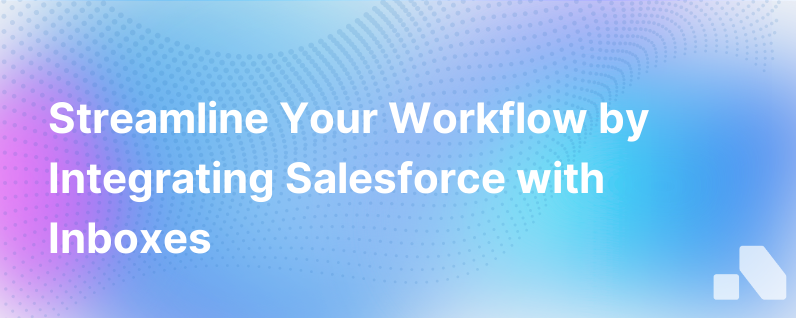Integrate Salesforce With Inboxes
Published on September 24, 2023 by David Zhang
In the era of digital transformation, the seamlessness of interaction between various business tools and platforms is less a luxury and more a cornerstone of operational efficiency. For sales teams, in particular, the integration of a customer relationship management (CRM) system with email inboxes is a critical component that enables better communication, enhanced organization, and ultimately, a more potent sales process.
Salesforce, as a leading CRM platform, has understood this for quite some time, providing robust integration capabilities with various email inboxes such as Gmail and Outlook. In this comprehensive guide, we’ll explore the importance of integrating Salesforce with your sales team's inboxes and provide a detailed roadmap on how to accomplish this.
The Importance of Salesforce and Inbox Integration
The integration of Salesforce with email inboxes is more than a simple bridge between two systems; it is an alignment of communication and data management that propels sales productivity forward. Some key benefits this integration brings include:
- Streamlined Workflow: By integrating Salesforce with email inboxes, sales representatives can access CRM data without toggling between applications. This minimizes disruption and fosters a cohesive workflow.
- Improved Data Accuracy: With automatic data capture from email correspondence, there is less risk of manual entry errors and more accurate account information within Salesforce.
- Enhanced Collaboration: Teams can track correspondence and share valuable insights, which can lead to more coordinated and strategic efforts when approaching leads and clients.
- Better Customer Insights: Recapping client communications is easier when those emails are logged in Salesforce, providing more context for each customer relationship and enabling personalized engagement.
- Increased Productivity: Automated tracking saves time for sales reps, allowing them to prioritize selling activities versus administrative tasks.
Integrating Salesforce With Your Inboxes
Now, let's dive into the steps needed to integrate Salesforce with inboxes effectively.
Step 1: Define Your Integration Goals
Before embarking on the integration journey, clearly define what you aim to achieve with the integration. Are you looking to synchronize contacts, archive emails automatically, track email open rates, or all of the above? Having clear objectives will guide the customization of the integration to your team's specific needs.
Step 2: Choose the Right Integration Tools
Salesforce provides a range of integration options for different email clients:
- Salesforce Inbox: A premium integration tool that brings Salesforce and your email inbox together. Compatible with various email clients, it offers features such as one-click email logging to Salesforce records and mobile access.
- Einstein Activity Capture: A feature of Salesforce that automatically captures emails and calendar activities, syncing them with corresponding Salesforce records.
- Outlook Integration and Salesforce for Gmail: Free tools provided by Salesforce that allow essential integrations with their respective email clients, enabling you to view Salesforce records from within your email and vice versa.
Step 3: Implement the Integration
Implementation steps can vary depending on the tool chosen, but here’s a general outline:
Salesforce Inbox:
- Purchase Salesforce Inbox licenses for your team.
- Install the Salesforce Inbox add-on in your email client.
- Connect your Salesforce environment following the guided setup flow, enabling syncing and logging as per your preferences.
Einstein Activity Capture:
- Set up Einstein Activity Capture from within Salesforce Setup.
- Assign permission sets to users.
- Define sharing settings that determine which users can see the captured activities.
Outlook Integration and Salesforce for Gmail:
- Install the Salesforce add-in from your email client's add-on market.
- Connect to Salesforce using OAuth.
- Configure the add-in to align with your account data and preferences.
Step 4: Customize Settings and Permissions
Customization is key to ensuring the integration meets your specific workflow needs. Define which email categories trigger logging to Salesforce, what the default visibility of logged emails should be, and which user groups need certain permissions within the integrated platforms.
Step 5: Train Your Team
Even the most elegant integration is useless if the team doesn't know how to leverage it. Provide comprehensive training that covers the ins and outs of the new system, best practices for daily use, and troubleshooting common issues.
Step 6: Monitor and Optimize
After implementation, closely monitor the system, collecting feedback from your sales teams and tracking key metrics to measure the integration's impact. Use these insights to fine-tune the setup, ensuring continuous improvement and user engagement.
Best Practices for Integration Maintenance
Like any system, integrations require ongoing attention to maintain their efficacy. Some best practices include:
- Regular Data Cleaning: Keep your Salesforce and email data accurate by conducting regular audits and data cleaning.
- Continual Training: Refresh training sessions as new features roll out or as team turnover introduces new users to the system.
- Stay Updated: Keep abreast of updates from Salesforce and your email provider to ensure you're taking advantage of the latest integration features.
- Seek Feedback: Continuously engage with your sales team to gather feedback and ensure the integration aligns with their evolving sales process.
Conclusion
Integrating Salesforce with your team's inboxes can unlock a host of benefits, catalyzing more effective sales operations and enabling a level of harmony between communication and customer management that's indispensable in today's fast-paced market.
Remember, the power of Salesforce inbox integration lies not merely in connecting two systems but in the strategic alignment of tools that streamline workflows, deepen customer insights, and foster data-driven decision-making to ultimately drive sales performance. By following the steps outlined in this guide, your B2B startup can harness the full potential of Salesforce inbox integration and sail towards greater productivity and sales effectiveness.